About Barbara Felty:
Barbara Felty of Middletown, PA, creates lovely, intricate decorated Easter eggs. She learned this traditional Eastern European craft from her Polish mother and grandmother, and she is passing it on to her own children and their children. In January 2021, she demonstrated her handiwork to folklorist Amy Skillman.
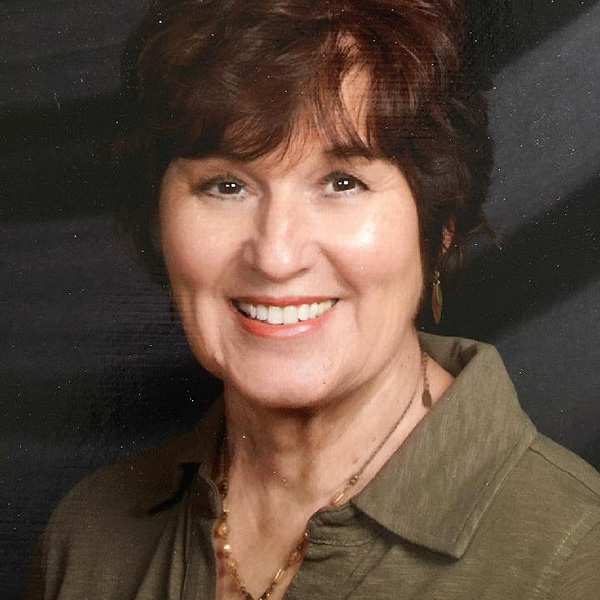
portrait of Barbara Felty courtesy of the artist - all other photos by Dennis Felty
About Barbara Felty
A family tradition
Barbara Felty has been decorating Easter eggs since she was a young girl. She learned from her mother, who learned from her mother, and on back through the generations. “It’s more of a tradition, a family tradition, more so than a public endeavor. I just do it for Easter, it’s a personal project.”
To decorate an Easter egg in this traditional way, the artist draws a pattern on the egg with melted wax. When the egg is dyed, the wax prevents the dye from being absorbed. After dying, the wax is removed, and the design remains on the surface of the egg. This process can be repeated to make multi-colored designs.
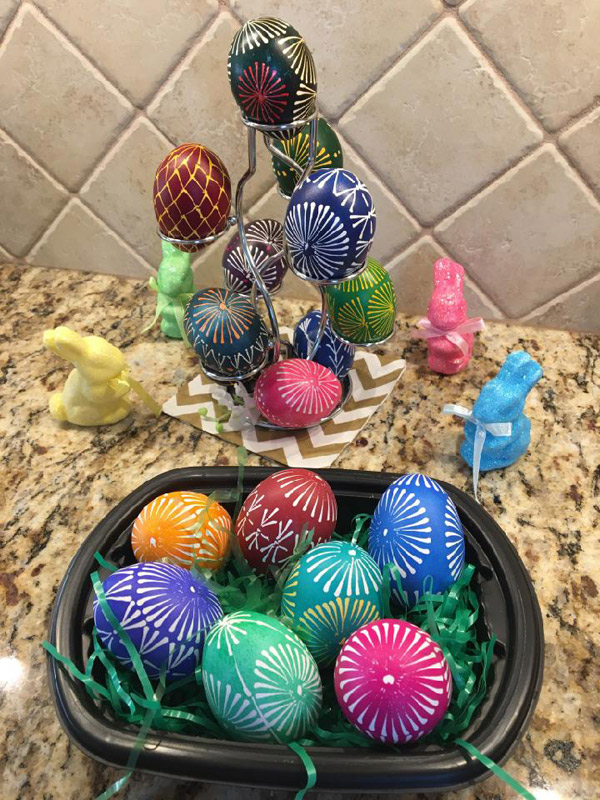
photo by Dennis Felty
Passed down through generations
What Barbara learned was the drop-and-pull method that is traditional to Eastern European countries such as Poland, Slovenia, Lithuania and the Czech Republic. She explains, “You would use either a pin or a nail... my grandmother, because she was a seamstress, would use a straight pin. She would put it in the eraser at the end of a pencil or taped onto a stick. And then you dip it into molten beeswax and you put it down on the egg and pull it so it becomes like a teardrop. Then you make various designs from that. And that’s what my grandmother taught my mother and my mother taught us.” When she was first learning with her mother, she says, “My job, usually because I was the littlest at the time, was to put the eggs into the dyes.” That was the beginning of her love of egg decorating.
“...a good childhood. It was full of love.”
Born in Wilkes Barre, Pennsylvania into a Polish immigrant family, Barbara remembers a big family full of love. Her grandparents on both sides came from Poland and found work in the thriving mines and textile mills of the early 20th Century. Her mother was a seamstress in the dress factory and her father fixed looms in a silk mill. “Every holiday, everybody came to Grandma’s house. My grandmother and my family and all my aunts and uncles were always in the house, eating and talking Polish. The kids were all shooed outside and we would play with the chickens and go through the garden. And my grandmother would give us tin cans with holes on the side and a string, and she would send us out into the fields where the mines were, because there were wild huckleberry bushes all over. And she would, say ‘pick the huckleberries’, so we would be gone all day long, picking huckleberries — eating more than we brought home. And that’s what you did. That was your vacation. You went to Grandma’s and played with your cousins and you ate a lot of good food.”
Historic creativity and symbolism
Although the decorated egg is generally associated with Easter, the practice goes back to pre-historic times, long before Christianity. An article by Stephanie Hall in the blog Folklife Today 1 describes a 2010 discovery of a cache of decorated ostrich eggs in South Africa, estimated to be between 55,000 and 65,000 years old. There were designs scratched onto the surface of the shell and it is speculated that these patterns indicated ownership. The eggs were most likely used to carry water, as people in the Kalahari Desert still do today.
In Jewish tradition, a pure white egg is part of the Seder plate at Passover, symbolizing the hagigah sacrifice and the cycle of life. According to that same article1, “Orthodox Christians in Mesopotamia took the symbol of the Passover egg and dyed it red as a symbol of Christ’s blood. This was the beginning of the Easter egg.”
Barbara acknowledges that in the Ukrainian Easter egg tradition, there is a lot of symbolism: from depictions of nature to spiritual iconography. Through time, the egg has been a symbol of good health, an expression of new life, a recognition of the cycles of the seasons, and a symbol of Christ’s resurrection. Barbara says, “When my mother was teaching us the technique, she never mentioned any kind of symbolism. She just taught us how to make designs.”
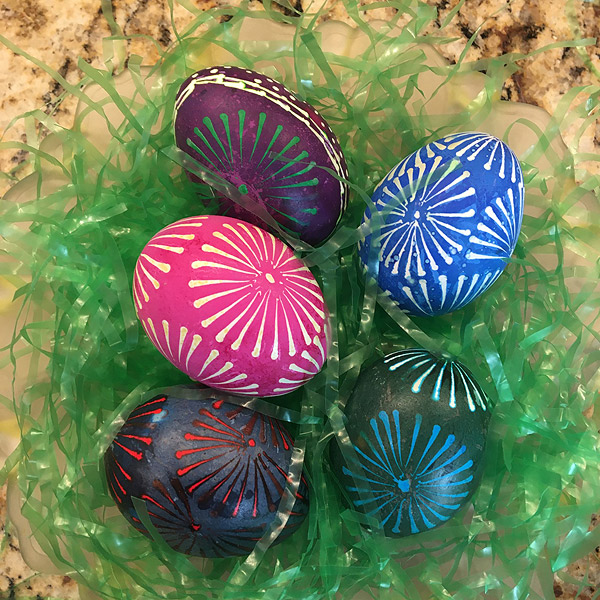
photo by Dennis Felty
Barbara makes them as gifts. Even as a child, “after we would make the eggs, we would give them away. You give them to family and friends. They were a sign of love and friendship, and that’s an Easter tradition. You didn’t save them.” She has a childhood memory of the parish priest coming to her house to bless the eggs and Easter bread. Then they would give the eggs away.
Her family moved to North Carolina when she was a little older and, although “it was hard to even find a Catholic Church, we kept making the eggs. I can remember I was in third grade, I think, and I took them to school for an egg hunt, and all the kids wanted to find my eggs, because they were so different.”
Egg aesthetics
When her grandmother was doing eggs, she used the natural dyes. “She used onions and beets to get the various colors because she lived on a farm and had gardens and she didn’t have dyes. She could use onion skins to get a yellow or brown, and beets for red. For black she would use walnuts or ashes; for violet there were sunflower seeds or elderberry. For green she could use a sprouting moss or wheat. And she would put that in the water and that was her dye.” Today, Barbara uses fast-acting powered pysanky dyes that she orders online. If children are helping, she recommends PAAS® Easter egg dyes or food coloring, which create more pastel colors but won’t ruin your table if spilled.
Barbara says, “It doesn’t take a great talent to do the drop and pull method. It does take persistence.” She says her mother’s eggs were beautiful. “The circles were perfect, just absolutely gorgeous, and when she went around the egg, everything matched and met perfectly. When I started to learn, nothing matched. It was up and down, it looked like chicken scratch. I mean, it was not a pretty sight. The only way you get better is just keep doing it and doing it until you get the feel for it. And that’s how my mother taught me.”
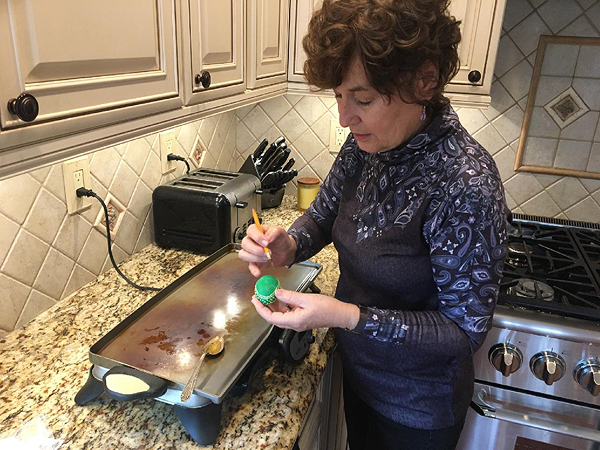
photo by Dennis Felty
When asked when she finally felt she had achieved competence, she says, “It was after I was married and working with my mother. Her egg was just gorgeous. And I was working with her and suddenly I realized, mine were still not quite as good as hers, but much better than past attempts.” “I do a lot of the designs my mother taught me. And then, you start making up your own, you just try it. And you look at the result and conclude that design is not a keeper. Other designs look nice. And that’s where the creativity comes in and you say, ah, I like that one.”
The process, start to finish
Most Ukrainian pysanky (Barbara says PISS-an-kee) artists blow the raw egg out of the shell through a little hole. But an empty eggshell floats when you put it in the dye, so you constantly need to move it around to get an even dye. Barbara was taught to hard-boil the eggs so they would sink to the bottom and you would not have to “mess with them.” And, if the egg doesn’t break or have any hairline cracks (which can be caused by the boiling process) you can keep them for years.
Minerals in the water will affect the colors in the dyes. Therefore, boil the eggs in distilled water and vinegar. Remove from the water and let them cool. Wash the eggs in distilled water and a mild soap (Ivory) to remove any sediments from the boiling process. Rinse in distilled water and let the eggs air dry on a towel. The eggs must be totally cool for the wax to stick, and totally clean so they will dye nicely. Wash your hands often!
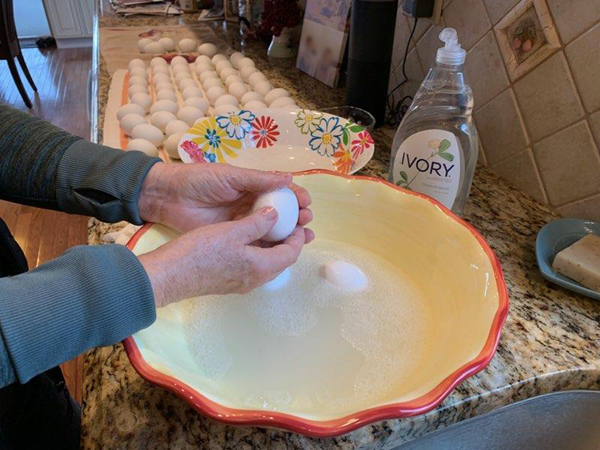
photo by Dennis Felty
Since Barbara makes several dozen eggs each year, she boils them a day or two in advance. Then she gets the dyes ready, which takes a while depending on how many colors she is using. Once the eggs and dyes are ready, it’s time to decorate.
Barbara melts the wax on a spoon that was her mother’s: “It’s a big spoon and she bent the handle to make it easy to work with.” She sets the spoon on a hot-plate or griddle (about 325°F) and adds pieces of the wax to melt. “Beeswax is the best. It needs to be a high quality wax so it will stay on the egg. My mother always used beeswax.”
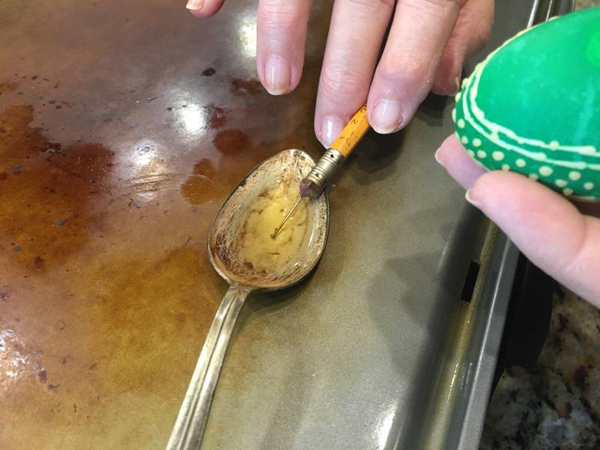
photo by Dennis Felty
Barbara’s tool for applying the melted wax is a sewing pin stuck into the eraser of a pencil. Barbara dips the head-end of the pin into the melted wax, sets it on the egg and then pulls it to make her teardrop line. She usually starts with a dot at the top of the egg: “That’s your center and then you go all the way around from there.” She calls this a pinwheel pattern.

photo by Dennis Felty
Once you have completed the pattern, you dip the egg in the dye until it reaches the density of color you want. Then you take it out of the dye, gently blot the excess liquid, and let it dry. If you want to add a second color, you repeat the process, putting wax on the places you want the earlier color to show through. You start with the lightest color and go darker with each new layer.
The photo below shows these steps. Barbara drew the dotted band pattern on the plain egg, and dyed the egg green. When that was dry, she added the pinwheels on both sides and re-dyed it with magenta. “When you’re doing those multiple colors, it just takes a while because you have to let the dye dry completely before you put wax over it again.”
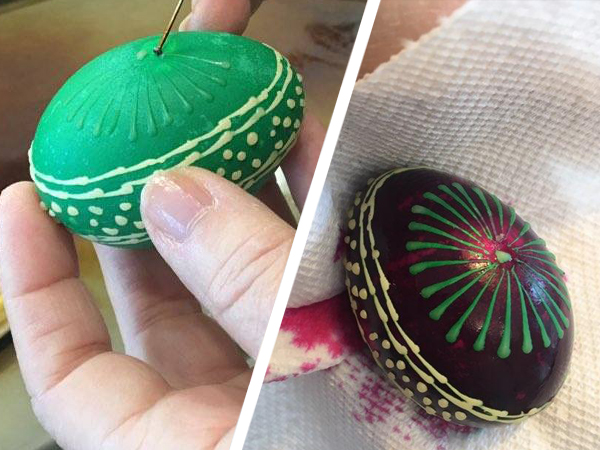
photo by Dennis Felty
When the egg is completely dry, you take the wax off to reveal the underlying color. There are several ways to do this. You can use a small spatula, but you might scratch the egg. You could use a candle to heat the wax and wipe it off. Or you can use a heat gun that blows hot air. “But you have to be careful that you don’t get the egg too hot. You just want it hot enough to be able to wipe that wax off.”

photo by Dennis Felty
Depending on how much time she has, Barbara might use as many as four colors on an egg. “I think the only thing that is consistent is my grandmother’s designs. Other than that, there are probably no two eggs alike. That’s why I’m hoping the old traditional designs don’t get lost.”
Passing it on
Barbara taught her own children to decorate Easter eggs in her grandmother’s style. They are all grown now and have their own families. But they are all local, so she is able to continue the tradition into the fifth generation. She will work on her own eggs for several days, and then “I’ll have a day or two where the family will come to make the eggs. We try not to have too many people all at once. Only two people at a time can access the wax. But they all come in at some point in time and they make eggs.” While they are all learning the traditional patterns, she notes that both her daughter and daughter-in-law get very creative with their designs, now.
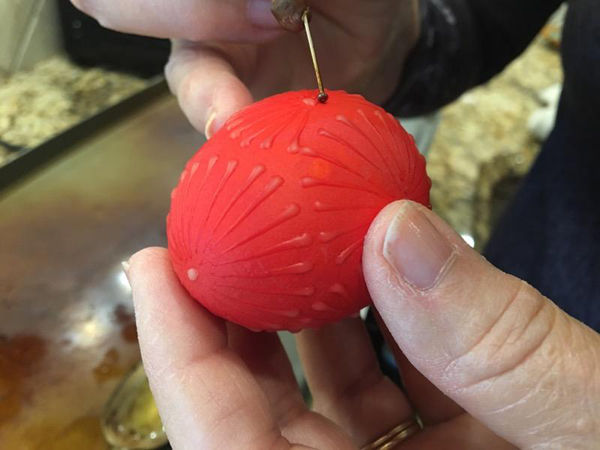
photo by Dennis Felty
“You give the best away”
Each year, Barbara still makes 9 or 10 dozen eggs and gives them away: to the priest, to the choir director at church, to her friends in the choir, to her family, and to her friends outside of church. She notes that the priest is usually the first to receive his gifts. “I look at what I’ve made and say, where are Father’s eggs? He needs to get the best because he is going to put them out for everybody to see. So, yes, I pick the best for him. And then I go from there.” When all the gifts are delivered, she keeps a few for herself. She laughs when she says, “My husband says, ‘You give the best away and keep the rest for us.’ ”
“I guess it brings back my roots, where I came from; my grandmother, my mother. When I’m making the eggs, all those memories come back... I have very little knowledge of my grandmother because she did not speak English; maybe a few words. But it is knowing that she brought this with her from Poland, taught my mother, and I am continuing that tradition. So, it’s a wonderful thing, a family gift. And I love the reaction I get when I give the eggs away. People don’t see this egg tradition often; it’s not something everybody does.”
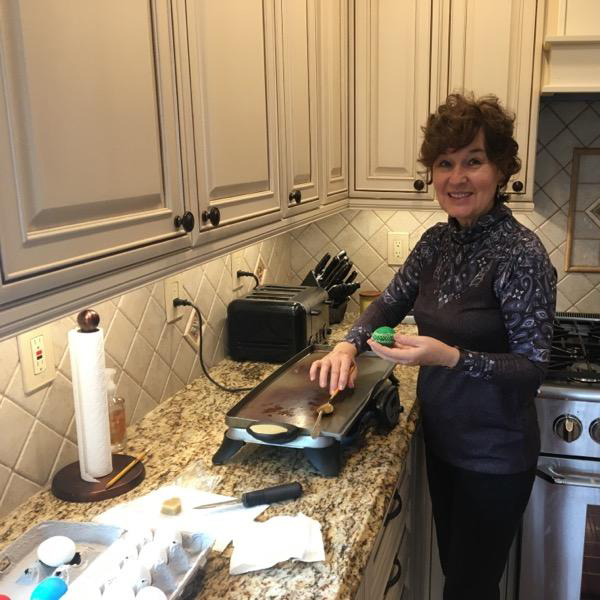
photo by Dennis Felty
Footnote:
1: Hall, Stephanie. 2017. “The Ancient Art of Decorating Eggs.” Folklife Today, a blog of the American Folklife Center, Library of Congress.



Brand icons for Facebook, YouTube, Instagram and other social media platforms are the trademark of their respective owners. No endorsement is implied.